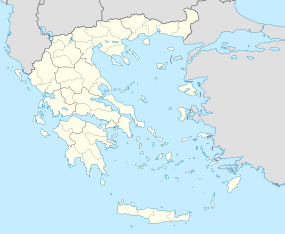Temple of Aphaia
| Ναός Αφαίας (Greek) | |

Temple of Aphaia from the southeast.
|
|
| Location | Agia Marina, Attica, Greece |
|---|---|
| Region | Saronic Gulf |
| Coordinates | 37°45′15″N 23°32′00″E / 37.75417°N 23.53333°ECoordinates: 37°45′15″N 23°32′00″E / 37.75417°N 23.53333°E |
| Type | Ancient Greek temple |
| Length | 80 m (260 ft) |
| Width | 80 m (260 ft) |
| Area | 640 m2 (6,900 sq ft) |
| History | |
| Founded | Circa 500 BC |
| Periods | Archaic Greek to Hellenistic |
| Satellite of | Aegina, then Athens |
| Site notes | |
| Condition | Erect with collapsed roof |
| Ownership | Public |
| Management | 26th Ephorate of Prehistoric and Classical Antiquities |
| Public access | Yes |
| Website | Hellenic Ministry of Culture and Tourism |
|
|
The Temple of Aphaia (Greek: Ναός Αφαίας) or Afea is located within a sanctuary complex dedicated to the goddess Aphaia on the Greek island of Aigina, which lies in the Saronic Gulf. Formerly known as the Temple of Jupiter Panhellenius, the great Doric temple is now recognized as dedicated to the mother-goddess Aphaia. It was a favorite of the neoclassical and romantic artists such as J. M. W. Turner. It stands on a c. 160 m peak on the eastern side of the island approximately 13 km east by road from the main port.
Aphaia (Greek Ἀφαία) was a Greek goddess who was worshipped exclusively at this sanctuary. The extant temple of c. 500 BC was built over the remains of an earlier temple of c. 570 BC, which was destroyed by fire c. 510 BC. The elements of this destroyed temple were buried in the infill for the larger, flat terrace of the later temple, and are thus well preserved. Abundant traces of paint remain on many of these buried fragments. There may have been another temple in the 7th century BC, also located on the same site, but it is thought to have been much smaller and simpler in terms of both plan and execution. Significant quantities of Late Bronze Age figurines have been discovered at the site, including proportionally large numbers of female figurines (kourotrophoi), indicating – perhaps – that cult activity at the site was continuous from the 14th century BC, suggesting a Minoan connection for the cult. The last temple is of an unusual plan and is also significant for its pedimental sculptures, which are thought to illustrate the change from Archaic to Early Classical technique. These sculptures are on display in the Glyptothek of Munich, with a number of fragments located in the museums at Aigina and on the site itself.
The periegetic writer Pausanias briefly mentions the site in his writings of the 2nd century AD, but does not describe the sanctuary in detail as he does for many others. The temple was made known in Western Europe by the publication of the Antiquities of Ionia (London, 1797). In 1811, the young English architect Charles Robert Cockerell, finishing his education on his academic Grand Tour, and Baron Otto Magnus von Stackelberg removed the fallen fragmentary pediment sculptures. On the recommendation of Baron Carl Haller von Hallerstein, who was also an architect and, moreover, a protégé of the art patron Crown Prince Ludwig of Bavaria, the marbles were shipped abroad and sold the following year to the Crown Prince, soon to be King Ludwig I of Bavaria. Minor excavations of the east peribolos wall were carried out in 1894 during reconstruction of the last temple.
...
Wikipedia

